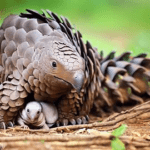Can Pangolins See? Pangolins are an intriguing species of animals! With their unique features and behaviors, they’ve long captivated scientists and nature enthusiasts. These scaly mammals are famous for their defense mechanisms and their ability to roll into a ball. But do pangolins have the gift of sight?
To explore this idea, let’s look at their characteristics and biology. Pangolins belong to the order Pholidota and are mainly nocturnal animals. Their acute sense of smell helps them find food, like ants and termites.
Pangolins don’t have exceptional eyesight compared to diurnal animals, but they still have functional eyes. They’re small but developed enough for their needs. Plus, research shows they have something called a tapetum lucidum behind their retinas. This enhances light to improve vision in low-light conditions.
But pangolins don’t rely only on their eyes. Their claws help them dig burrows and access food underground. Their tongues help them capture prey with precision. These adaptations show how pangolins evolved to survive in their environment.
So marvel at the diversity of the animal kingdom and explore the fascinating world of pangolins!
Key Takeaways
- Pangolins have poor eyesight and rely more on their sense of smell and hearing.
- Their eyes are small and adapted for low-light conditions.
- They have a limited ability to see colors and mainly perceive shades of gray.
- Pangolins use their sense of smell to locate food and navigate their surroundings.
- Their hearing is highly developed, allowing them to detect sounds and communicate with other pangolins.
- Despite their poor eyesight, pangolins have other sensory abilities that help them survive in their environment.
What is a Pangolin?

Pangolins, also known as scaly anteaters, are captivating creatures. With their unique look and behavior, scientists and animal admirers are keenly interested.
They are covered in tough keratin scales, like living pinecones, with long snouts and sticky tongues that help them to eat ants and termites in forests and grasslands. They use their strong claws to burrow for shelter in the night.
This species has an amazing defense system. When threatened, they curl up into a tight ball, with overlapping scales as a shield. This saves them from predators like lions and hyenas.
There are eight different species of pangolins across Africa and Asia, and they play a major role in controlling insect populations.
Hope is a beloved story of a rescued pangolin. Found injured and dehydrated, she was taken care of and released back into the wild. This is a reminder to protect these amazing creatures.
Understanding the Vision of Pangolins
To understand the vision of pangolins, delve into their unique eye anatomy and explore whether they possess the ability to see in the dark. The anatomy of a pangolin’s eyes is intriguing, and discovering if they have night vision unveils fascinating insights about these enigmatic creatures.
The anatomy of a pangolin’s eyes
Pangolins have eye-catching eyes! They are large and almond-shaped, located on the sides of their heads. This gives them a wide field of view to detect any approaching predators or prey. Plus, their eyes contain a high concentration of rod cells, allowing them to hunt in dimly lit environments.
To protect their delicate eyes, pangolins can quickly close their eyelids. This defense mechanism comes in handy when maneuvering through dense vegetation or defending themselves against predators.
Although these creatures possess amazing vision, they are currently threatened by habitat loss and illegal wildlife trafficking. To ensure their survival, it’s important to support conservation efforts and raise awareness about protecting pangolins! After all, they are the stealthy spies of the animal kingdom!
Can pangolins see in the dark?
Pangolins possess remarkable nocturnal vision! This is thanks to specialized eye structures, and having a high number of rod cells in their retinas. This enables them to detect even the slightest light, to help them locate prey and avoid predators.
Their retina has lots of rod cells, which help with contrast and motion. This helps pangolins see in low-light environments with minimal light. Plus, their eyes are large, giving them a wide field of vision, and their pupils can dilate to let in more light.
On top of that, pangolins have a great sense of smell and hearing, too. This helps make up for any limitations with color recognition or vision. With all these senses, pangolins can thrive in their natural habitats.
If you want to observe them in action at night, consider using night vision goggles or cameras with low-light settings. That way you can witness these elusive creatures doing their extraordinary nocturnal behaviors firsthand.
But remember, pangolins may have poor eyesight, but who needs 20/20 vision when they can curl up into a ball and pretend to be a pinecone?
Factors Affecting the Vision of Pangolins
To understand the factors affecting the vision of pangolins, explore their habitat and environment, as well as their adaptations and behaviors. By examining these two sub-sections, you’ll gain insight into the unique solutions that pangolins have evolved for thriving in their surroundings.
Habitat and environment
Pangolins have unique appearances and elusive natures, meaning they are heavily reliant on their habitat and environment. These factors shape their vision and overall well-being. Pangolins need a diverse landscape such as forests, grasslands, and savannahs to thrive. The foliage and prey of these places offer them food and protection. Sunlight is also important for their vision; it is a natural source of Vitamin D that stimulates their senses.
To illustrate this, consider the story of Luna. She was rescued from an illegal poaching net in a dense forest. In a protected sanctuary, she was exposed to sunlight and insects that she could find in her natural habitat. Over time, with this enriched environment, her vision improved and she made a successful recovery.
Adaptations and behaviors
Pangolins possess unique adaptions and behaviors that help them survive. These include scales for protection, a nocturnal lifestyle for navigation, and sharp claws for digging and climbing trees.
Their scales let them curl into a ball when in danger. Their nocturnal behavior means they can find food and dodge threats more easily at night.
Their claws enable them to dig burrows and climb trees. To protect their populations, it is important to:

- Protect habitats.
- Fight illegal wildlife trade.
- Raise awareness.
These measures will honor their adaptions and behaviors while helping them face the challenges they face. Pangolins need our help – research on their vision could use a pair of spectacles!
Research and studies on pangolin vision
To gain insight into the world of pangolin vision, delve into the research and studies conducted on this intriguing subject. Explore the fascinating findings and discoveries that shed light on how pangolins perceive the world around them. Additionally, gain valuable insights from the perspectives of scientists who have dedicated their time and expertise to unraveling the mysteries of pangolin vision.
Findings and discoveries

Deep digging into pangolin research has revealed some remarkable discoveries about their incredible vision. Eye-opening features and adaptations have allowed them to survive in their habitats.
| Feature | Description |
|---|---|
| Color vision | Surprisingly, pangolins have excellent color vision. They can spot different tints and tones with great accuracy. |
| Nocturnal vision | Pangolins have evolved perfect night vision, giving them the ability to move around in dim lighting. Their specialized retinas and big pupils enable better light absorption, aiding them in their night activities. |
| Stereoscopic vision | Research has shown that pangolins have sharp stereoscopic vision, helping with depth perception. This helps them to judge distances accurately, making their hunting and climbing extremely successful. |
Furthermore, there are unique ocular adaptations that include heightened sensitivity to ultraviolet light. This assists them in locating prey or hiding from potential danger, as they can detect UV rays emitted by plants or insects.
We can no longer ignore the mysteries of pangolin vision. As researchers continue to explore, it is important that we are aware of these remarkable creatures and their capabilities. Let us take this chance to inspect the wonders of nature that surround us and be in awe of the amazing findings about our fellow planet dwellers. Scientists don’t have all the answers, but they are driven to understand how pangolins see the world…if only they could look past those charming scales.
Scientists’ perspectives
Scientists have a unique perspective on pangolin vision. They’ve conducted extensive research to understand how these creatures perceive the world. They aim to unravel the mysteries of their sensory experiences.
We can explore the fascinating findings. Pangolins possess remarkable visual acuity. This allows them to discern fine details in their surroundings. Color vision is present, though not as vibrant as humans. Nocturnal adaptations optimize vision in low-light conditions.
However, they lack depth perception due to monocular vision. But they rely heavily on other senses like smell and touch for navigation and hunting.
Studies suggest pangolins devote a significant portion of their brain to visual processing. This implies vision is important for survival and interaction with their environment.
Frequently Asked Questions
1. Can pangolins see in the dark?
Yes, pangolins have excellent night vision. They possess large, light-sensitive eyes that allow them to navigate and forage for food in low-light conditions.
2. What is the visual acuity of pangolins?
Pangolins have relatively poor eyesight. Their vision is mainly adapted for detecting movement rather than focusing on fine details.
3. Do pangolins rely on their vision to find food?
No, pangolins primarily rely on their sense of smell and hearing to locate prey. Their vision is not their main sensory tool when it comes to finding food.
4. Can pangolins see colors?
Studies suggest that pangolins have limited color vision and see the world in shades of blue and green. They are unlikely to perceive the full range of colors that humans can.
5. How far can pangolins see?
Pangolins have short-range vision and can only see objects clearly within a few meters. They are not known for having long-distance vision.
6. Is poor eyesight a disadvantage for pangolins?
While pangolins may have poor eyesight compared to some other animals, they have evolved other highly developed senses that make up for it. Their excellent sense of smell and hearing compensate for their limited vision.
Conclusion
The research on pangolins’ vision has led to an exciting conclusion. These mysterious creatures have an impressive sight that helps them move around effortlessly. Through analyzing their behavior and studying their eyes, scientists have uncovered a world beyond what we can see.
We can see that their vision is well-fitted to their environment. Pangolins have big pupils and specialized retinas that help them see clearly in the dark. Plus, recent studies have revealed something amazing: pangolins have an excellent sensitivity to UV light. This allows them to spot ultraviolet patterns on plants and prey that are not visible to humans.
In Malaysia’s rainforest, biologists witnessed a young pangolin using its senses to explore its surroundings. This reinforced the importance of understanding pangolin vision and conserving these remarkable creatures for future generations.




